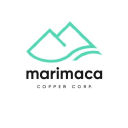Pampa Medina Drilling Validates Sedimentary-Hosted Copper Manto Model & Reinforces Marimaca's District-Scale Growth Optionality

Marimaca Copper's Pampa Medina drilling validates high-grade manto copper system with 48m at 2.05% Cu, boosts district growth beyond MOD's 50ktpa capacity.
- Marimaca Copper's November 11, 2025 drilling results from Pampa Medina confirm the continuity of a stratiform sedimentary-hosted manto system, validating the geological model across a 1.6 kilometre by 1.4 kilometre corridor.
- High-grade intercepts including 48 metres at 2.05% copper, 16 metres at 2.29% copper, and 6 metres at 3.17% copper strengthen confidence in a growing sulphide horizon that remains open in multiple directions.
- Results enhance the company's district-scale hub-and-spoke strategy, supporting the goal of expanding beyond the 50,000 tonnes per annum production case outlined in the 2025 Definitive Feasibility Study.
- Following the announcement, Marimaca commenced a 30,000 metre Phase II program with five rigs deployed on site, positioning the project for significant resource definition and future economic studies.
- As the copper market faces structural supply constraints driven by electrification, grid expansion, and declining discovery rates, Pampa Medina enhances Marimaca's long-term strategic value for investors seeking low-capex, scalable copper exposure.
Copper Supply Constraints Accelerate the Search for New Scalable Districts
The copper market faces a fundamental imbalance between accelerating demand and constrained supply response. Electric vehicle penetration, grid expansion requirements, artificial intelligence-driven power infrastructure, and renewable energy deployment collectively drive multi-year growth projections that outpace historical consumption trends. These demand drivers create structural requirements for new copper supply at a scale that cannot be satisfied by existing production pipelines.
Supply growth faces multiple constraints despite elevated copper prices. Declining ore grades across major operations reduce effective output even as nominal production targets are maintained. Underinvestment in new project pipelines during the 2015-2020 period created a development gap that cannot be quickly remedied given lengthy construction timelines. Lengthening permitting windows and escalating environmental, social, and governance requirements add further constraints to supply growth, particularly in jurisdictions with established mining sectors.
This supply-demand dynamic has shifted investor preference toward low-altitude, capex-light, near-term development projects with district-scale upside potential. Chief Executive Officer Hayden Locke frames this opportunity within Marimaca Copper’s broader strategic positioning:
"We are coming to market with a new project at exactly the right time."
Why Sedimentary-Hosted Copper Manto Systems Matter for Developers
Growing investor focus on sedimentary-hosted copper manto systems reflects their distinct advantages for developers seeking to advance projects efficiently. Manto systems are characterized by shallow mineralization, lateral extensiveness, structural predictability, and lower-cost resource definition compared to porphyry or skarn systems requiring deeper drilling campaigns.
Stratiform mineralization hosted in sedimentary sequences tends to exhibit consistent geometries that can be efficiently modeled with fewer drill holes compared to structurally complex deposits. This geological predictability supports rapid resource conversion from inferred to indicated categories, accelerating the path toward economic studies and financing decisions.
Pampa Medina's Geological Model Validated: A Material Technical De-Risking Event
Marimaca completed the Phase I discovery drilling campaign at Pampa Medina, with results announced November 11, 2025. The 10,000 metre program sought to validate the sedimentary-hosted geological model, identify sulphide feeder horizons, and test oxide continuity across the prospect area. The drilling footprint covered 1.6 kilometres by 1.4 kilometres while remaining open to the north and west, indicating substantial exploration potential beyond currently defined boundaries.
Phase I results confirmed that mineralization is hosted within a coherent sedimentary sequence with identifiable stratigraphic controls, reducing geological risk and strengthening the basis for converting inferred resources to indicated categories in subsequent estimation work.
High-Grade Results Reinforce the Presence of a Growing Sulphide Core
The Phase I drilling program delivered multiple high-grade intercepts that demonstrate both grade continuity and scale potential within the sulphide system. Hole SMRD-22 intersected 48 metres at 2.05% copper within a broader 160 metre interval grading 0.92% copper that includes oxide mineralization. Hole SMR-19 returned 16 metres at 2.29% copper within 28 metres at 1.44% copper, exclusively within sulphide zones. Hole SMR-07 encountered 6 metres at 3.17% copper within 14 metres at 1.69% copper, representing the highest-grade intercept from the campaign.
Additional results include hole SMRD-20, which intersected 38 metres at 1.48% copper within a broader 90 metre interval grading 0.96% copper. These intercepts collectively suggest a laterally continuous sedimentary horizon, with primary mineralization observed at depths exceeding 300 metres. The presence of high-grade sulphide cores within broader mineralized envelopes indicates potential for selective mining scenarios or blending strategies that could enhance future economic outcomes.
The consistency of high-grade intersections across the drilling footprint supports interpretation of a coherent feeder system rather than isolated pods of mineralization. This geological continuity is essential for district-scale resource potential and underpins the technical rationale for the expanded Phase II drilling program.
Oxide Extensions Add Optionality to Marimaca's Future Development Path
Near-surface oxide mineralization at Pampa Medina extends over significant thicknesses, with oxide zones varying from a few metres up to more than 200 metres in certain areas. The mineralization comprises atacamite, chrysocolla, and secondary chalcocite mineralogy. The presence of substantial oxide zones above the primary sulphide horizon creates operational optionality for future development scenarios. Oxide material could serve as satellite feed to the MOD processing facility, reducing incremental capital expenditure requirements compared to standalone development.
The integration of oxide feed into an existing processing hub could accelerate cash flow generation and improve net present value in future district-level economic studies. The oxide zones at Pampa Medina therefore represent both near-term production optionality and a potential bridge to sulphide development as the district-scale strategy evolves.
Strategic Implications: How Pampa Medina Reinforces Marimaca's District-Scale Growth Plan
The MOD deposit serves as the central processing hub within Marimaca's district strategy, with the Definitive Feasibility Study completed August 25, 2025 for a 50,000 tonnes per annum design case. Pampa Medina represents a potential future sulphide and oxide spoke that could extend mine life, increase throughput, reduce operating redundancy, and elevate long-term copper output beyond the initial MOD production profile.
This hub-and-spoke configuration aligns with investor preference for scalable districts rather than single-asset developers vulnerable to resource depletion. Shared infrastructure reduces per-tonne capital intensity for satellite deposits. Centralized processing allows for blending strategies that optimize grade profiles and metallurgical performance. Sequential development of satellite deposits provides a visible pipeline of growth catalysts that can sustain investor interest and support equity rerating over multi-year periods.
MOD DFS Economics Provide the Foundation for Expansion
The MOD Definitive Feasibility Study completed August 25, 2025 delivered robust base case economics that provide the financial foundation for district expansion scenarios. The study outlined a net present value at 8% discount rate of US$709 million, an internal rate of return of 31%, and an earnings before interest, taxes, depreciation, and amortization margin of 58%. All-in sustaining costs of US$2.09 per pound position MOD in the second quartile of the global cost curve, providing margin resilience across price cycle scenarios.
Capital intensity of US$11,700 per tonne per annum ranks among the lowest among copper development peers, reflecting the benefits of low-altitude location, simple open pit mining, and conventional processing technology. Strong underlying margins at MOD absorb incremental development risk associated with satellite deposits and support future expansion studies without compromising the base case economics.
Phase II Drilling: The Catalyst That Will Define the District's Long-Term Value
Following the November 11 announcement, Marimaca commenced a 30,000 metre Phase II drilling program with five rigs deployed on site. The program focuses on three primary objectives: north and west step-out drilling to test the lateral extent of mineralization, expansion of the sulphide core to increase tonnage potential, and testing oxide footprint continuity to define potential near-term production scenarios.
Step-out drilling is particularly significant given that mineralization remains open in multiple directions, suggesting potential for a materially larger resource envelope than currently defined. Demonstrating continuity beyond the current drilling footprint would validate the interpretation of a district-scale manto system rather than a localized deposit. This distinction materially affects valuation multiples applied by investors, as district-scale systems command premiums reflecting long-term production potential and exploration upside.
Geophysics & Additional Technical Work Planned for 2025
The company intends to complete geophysical surveys during 2025 as part of the broader exploration program. Geophysical methods including induced polarization and electromagnetic surveys can identify subsurface conductivity anomalies associated with sulphide mineralization, improving drilling efficiency by reducing the number of holes required to define deposit geometry. The expected outcome from integrated geophysics and drilling is better targeting precision, reduced drilling risk, and refined geological domains for future mineral resource estimates.
Implications for Future Mineral Resource Estimates
Phase II drilling data will likely support several technical advances critical for investor confidence. Higher-confidence resource classification from inferred to indicated categories reduces technical risk and enables more detailed engineering studies. Enlargement of sulphide tonnage expands the potential economic contribution from Pampa Medina within district development scenarios. Definition of new oxide envelopes provides near-term production optionality that could accelerate cash flow generation.
For investors, a larger resource base underpins future economic studies and derisks financing by demonstrating sufficient tonnage to support long-life production scenarios. Resource growth at Pampa Medina would strengthen the district development narrative and could justify upward revisions to valuation metrics based on expanded production profiles.
Pampa Medina Adds Scarcity Value in a Region Dominated by Depletion & Rising Costs
Chile's established copper operations face structural challenges from declining ore grades and rising operating expenditures. Grade depletion increases both costs and environmental footprint per unit of copper produced, creating strategic value for new discoveries offering higher grades and simpler processing requirements.
Pampa Medina offers a rare combination of advantageous characteristics within the Chilean copper landscape. Low-altitude access reduces logistical costs and operational complexity. Shallow drilling depths minimize exploration costs and accelerate resource definition timelines. Simple metallurgy avoids the processing challenges associated with refractory or complex mineralogy requiring specialized treatment. High-grade sulphide intersections support competitive unit costs even in inflationary cost environments. This combination of attributes is increasingly scarce in the global copper development pipeline.
Strong Balance Sheet Supports Sustained Exploration & Study Work
As of September 2025, Marimaca maintained a debt-free balance sheet. The company reported US$24.3 million in cash as of June 30, 2025, prior to completing an A$80 million (approximately US$53 million) financing. This capital position provides runway to fund multi-rig drilling campaigns, advanced engineering studies, and permitting work without immediate dilution risk. As of September 2025, strategic backing included Greenstone Resources (22.3%), Assore Limited (16.3%), and Mitsubishi Corporation (4.0%), providing both financial credibility and potential strategic advantages in project financing and offtake arrangements.
Management Track Record Reduces Execution Risk
Marimaca's technical team includes founder-level personnel who made the original MOD discovery, providing continuity and geological knowledge essential for district-scale exploration. The company engaged Ausenco Engineering and NCL Ingenieria y Construccion for Definitive Feasibility Study execution, leveraging experienced engineering firms to ensure study quality and credibility with potential financing partners.
Risks & Constraints: What Could Challenge the Investment Case?
The continuity of sulphide horizons beyond current drill zones remains unproven pending completion of Phase II step-out drilling. While Phase I results demonstrate mineralization over a 1.6 kilometre by 1.4 kilometre footprint, extension to true district scale requires successful drilling in untested areas. Northern and western step-outs are required to confirm district-scale geometry and support resource estimates sufficient to justify standalone development or material contribution to district production profiles.
Permitting & Timeline Risks
MOD is advancing permitting toward a target Final Investment Decision in the second half of 2026, subject to permitting approvals and other conditions. Development decisions for Pampa Medina would follow MOD, subject to successful Phase II resource definition and additional economic studies. Chile's permitting framework involves multi-agency review processes including environmental impact assessment, water rights allocation, and community consultation requirements.
The MOD project qualified for a DIA (Declaración de Impacto Ambiental) environmental approval process. However, timeline risk stems from potential delays in permitting processes, which can extend project schedules and increase carrying costs. While Chile has seen increased consensus among political and regulatory agencies about the importance of economic growth, the permitting process remains rigorous and subject to technical review periods and stakeholder consultation requirements.
Cost & Execution Risks
Inflationary pressures in labor and consumables affect all Chilean mining operations, with particular impact on drilling costs, engineering services, and construction materials. These cost pressures can erode project economics if not offset by productivity improvements or higher copper prices. However, Pampa Medina's low-altitude location mitigates some logistical challenges compared to high-altitude operations requiring specialized equipment and facing weather-related operational constraints.
Chief Executive Officer Hayden Locke provides perspective on the team's performance and outlook:
"We're happy with the plan we've got. We're very happy with how the team's performing and we see a pretty clear path ahead for the next phase of development”
The Investment Thesis for Marimaca Copper
- Structural copper supply constraints emerging from electrification, grid expansion, and infrastructure renewal are increasing the value of scalable development assets with near-term production potential and district-scale resource growth opportunities.
- Validation of the sedimentary-hosted manto model at Pampa Medina derisks future resource definition work and suggests potential for large, laterally extensive sulphide systems that could support decades of production within an integrated district framework.
- Strong economics demonstrated at MOD in the August 2025 Definitive Feasibility Study, with low all-in sustaining costs of US$2.09 per pound, 31% internal rate of return, and industry-leading capital intensity of US$11,700 per tonne per annum, provide the financial backbone for district-scale growth while maintaining competitive cost structures across price cycle scenarios.
- Ongoing 30,000 metre Phase II drilling program with five rigs deployed offers near-term catalysts through resource expansion, improved geological confidence, and potential for equity rerating as the scale of the district becomes clearer through systematic exploration.
- Scarcity of new copper districts combining low altitude access, simple metallurgy, strong infrastructure support, and high-grade sulphide potential positions Marimaca uniquely within the copper development universe as supply constraints intensify.
- Strong balance sheet with debt-free status as of September 2025 and completion of an A$80 million financing supports sustained exploration and development work without immediate dilution risk, allowing management to execute optimal technical programs.
- Experienced technical team with discovery track record at MOD and engagement of credible engineering firms including Ausenco and NCL reduces execution risk during critical resource definition and study phases.
- Target Final Investment Decision for MOD in the second half of 2026 provides a clear near-term catalyst for project advancement, with the company already holding environmental approval and targeting construction commencement in early 2026.
Pampa Medina Positions Marimaca for Multi-Stage Rerating Potential
Pampa Medina's Phase I success, with results announced November 11, 2025, confirms a stratiform manto system with substantial sulphide and oxide upside that materially strengthens Marimaca's district-scale strategy. The drilling results demonstrate geological continuity across a significant footprint while remaining open in multiple directions, validating the technical foundation for future resource and economic studies. High-grade intercepts including 48 metres at 2.05% copper and 16 metres at 2.29% copper establish confidence in a growing sulphide core with potential to support long-term production scenarios.
With Phase II drilling now underway utilizing five rigs across a 30,000 metre program, investors should expect a steady cadence of drilling updates that will clarify the deposit's size, economic contribution, and integration potential within the broader MOD development timeline. The combination of proven economics at MOD from the August 2025 Definitive Feasibility Study, expanding resources at Pampa Medina, and a strong balance sheet supporting sustained technical work positions the company to capture value from structural copper market tightness.
TL;DR
Marimaca Copper's November 11, 2025 drilling results from Pampa Medina validate a sedimentary-hosted copper manto system across a 1.6 kilometre corridor with high-grade intercepts up to 48 metres at 2.05% copper. The results confirm geological continuity and support the company's district-scale hub-and-spoke development strategy centered on the MOD deposit, which demonstrated robust economics in the August 2025 Definitive Feasibility Study with 31% internal rate of return and US$2.09 per pound all-in sustaining costs. A 30,000 metre Phase II program commenced following the announcement with five rigs deployed on site, targeting resource expansion in areas that remain open to the north and west. As copper markets face structural supply constraints from electrification and declining discovery rates, Pampa Medina enhances Marimaca's strategic positioning by offering scalable, low-capex exposure with district-scale growth potential beyond the initial 50,000 tonnes per annum MOD production case.
FAQs (AI-Generated)
Analyst's Notes




Subscribe to Our Channel
Stay Informed























